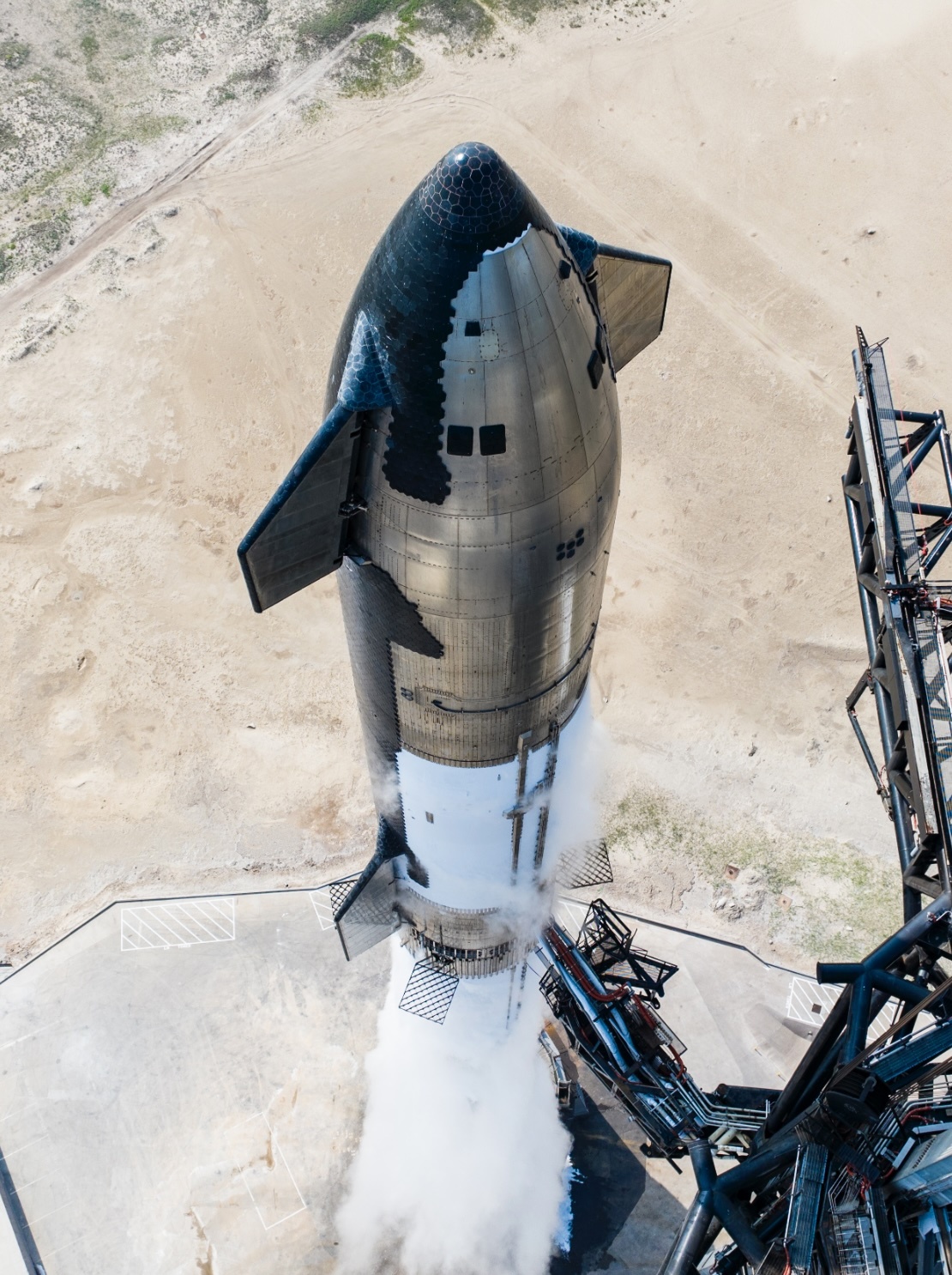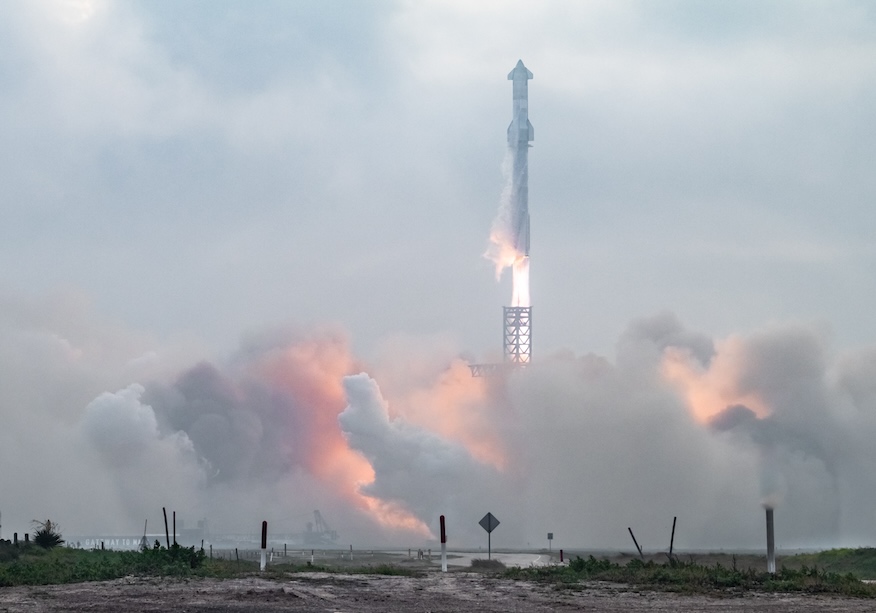26.05.2024
SpaceX details learnings from Starship Flight 3, sets June 5 as target launch date for Flight 4

SpaceX is preparing to launch its massive Starship rocket on its fourth flight test from its Starbase facilities in southern Texas as soon as June 5. The target launch date comes a little less than three months after Flight 3 on March 14.
In a pair of posts on its website, SpaceX outlined the learnings from Flight 3, the mission objectives for Flight 4 and the differences between the timing of everything between these two pieces of the development campaign.
The Flight 4 launch window is set to open on June 5 at 7 a.m. CDT (8 a.m. EDT (1200 UTC). However, as SpaceX points out, they are still waiting on regulatory approval from the Federal Aviation Administration (FAA).
In this latest go-around, SpaceX isn’t going to attempt some of the additional flight items it tried during Flight 3, like operating the payload bay door or reigniting the vacuum engines on the upper stage.
“The fourth flight test turns our focus from achieving orbit to demonstrating the ability to return and reuse Starship and Super Heavy,” SpaceX said in a statement. “The primary objectives will be executing a landing burn and soft splashdown in the Gulf of Mexico with the Super Heavy booster, and achieving a controlled entry of Starship.”
Lessons learned
In a blog post, SpaceX outlined a number of items from Flight 3 that went according to plan and others that led to the mishap. Among the successes was completing a propellant transfer demonstration, “moving liquid oxygen from a header tank into the main tank.”
“This test provided valuable data for eventual ship-to-ship propellant transfers that will enable missions like returning astronauts to the Moon under NASA’s Artemis program,” SpaceX said in a statement.
As with Flight 2, Flight 3 also saw a successful ascent of the rocket through stage separation. Building on that second flight, the most recent go around also saw the Starship upper stage make it through a full-duration ascent burn.
However during Flight 3, SpaceX said a blocked filter “where liquid oxygen is supplied to the engines” on the Super Heavy booster caused “a loss of inlet pressure in engine oxygen turbopumps.” It said this is likely the root cause of an early shutdown for six the 13 Raptor engines used during the boostback burn.

When it came time for the landing burn, the six engines that prematurely shut down were disabled and of the seven remaining engines, only two were determined to have successfully achieved “mainstage ignition.”
“The booster had lower than expected landing burn thrust when contact was lost at approximately 462 meters in altitude over the Gulf of Mexico and just under seven minutes into the mission,” SpaceX explained.
SpaceX said more hardware improvements within the oxygen tanks are coming for the Flight 4 Super Heavy booster and those beyond it “to further improve propellant filtration capabilities.” They will also add new hardware and software “to increase startup reliability of the Raptor engines in landing conditions.”
During its reentry from space, the Starship upper stage suffered from a lack of attitude control, seen as the rocket began rolling unintentionally, leading to “the ship seeing much larger than anticipated heating on both protected and unprotected areas.”
“The most likely root cause of the unplanned roll was determined to be clogging of the valves responsible for roll control,” the company said. “SpaceX has since added additional roll control thrusters on upcoming Starships to improve attitude control redundancy and upgraded hardware for improved resilience to blockage.”
Timeline adjustments
In addition to some of the alterations on the hardware and software, eagle eyed observers of the mission timelines will also pick up on some other key differences. One of the notable pre-launch changes involves the fueling process.
During Flight 3, SpaceX began by loading the Starship upper stage with liquid oxygen first at T-53 minutes, followed by loading liquid methane on the Ship two minutes later. Flight 4 flips that around and stars with liquid methane first at T-49 minutes and then liquid oxygen two minutes after that.
Similarly on the Super Heavy booster, Flight 3 started with liquid oxygen loading at T-42 minutes and then liquid methane a minute later. Flight 4 begins with liquid methane at T-40 minutes and then liquid oxygen three minutes after that.
SpaceX did not state a reason for the reversals in the fueling process, but they have been doing quite a bit of work to modify the storage tanks for both the liquid oxygen and liquid methane in the tank farm near the pad. The vertical tanks were replaced with horizontal ones over the past several months as part of the work on the ground systems.
All told, the timing for fueling Starship is set to be about four minutes shorter than the last flight. It’s also only about 11 minutes longer than it takes to fully fuel a Falcon 9 rocket.
The launch timeline is also somewhat tweaked. While the end of the mission, pegged as “An exciting landing!” remains at roughly the same time (in the ballpark of 1 hour and 5 minutes), Flight 4 streamlines much by removing some of the additional flight goals.
Three key events were added to the timeline though, one near liftoff and two towards the end of the mission.
Following the Super Heavy booster performing the boostback burn, just before the four-minute mark, SpaceX will jettison the hot-stage adapter, which was added between the first and second flights of Starship.
SpaceX said they are doing this “to reduce booster mass for the final phase of flight.”
The other two events added in this next go around include the so-called “landing flip” at T+01:05:38, followed by the landing burn five seconds later.
“Flight 4 will fly a similar trajectory as the previous flight test, with Starship targeted to splashdown in the Indian Ocean,” SpaceX said. “This flight path does not require a deorbit burn for reentry, maximizing public safety while still providing the opportunity to meet our primary objective of a controlled Starship reentry.”
Path to launch
As SpaceX noted on Friday, the target launch date of Wednesday, June 5, hinges on getting approval from the FAA. The SpaceX-led mishap investigation following Flight 3 remains ongoing, but the company is hoping to use a preexisting clearance mechanism within the FAA’s rules to return to flight before the investigation is fully closed out.
“During Flight 3, neither vehicle’s automated flight safety system was triggered, and no vehicle debris impacted outside of pre-defined hazard areas,” SpaceX said. “Pending FAA finding of no public safety impact, a license modification for the next flight can be issued without formal closure of the mishap investigation.”
When reached for comment on Friday, the FAA told Spaceflight Now that it received SpaceX’s request for a public safety determination and should they agree, SpaceX could in fact fly while the mishap investigation progresses.
“The FAA is responsible for and committed to protecting the public during commercial space transportation launch and reentry operations,” the FAA stated. “On April 5, SpaceX requested that the FAA make a public safety determination as part of the ongoing investigation into the Starship OFT-3 mishap event. The FAA is reviewing the request and will be guided by data and safety at every step of the process.”

Getting to launch as much and as often as possible is important for SpaceX’s development process and to NASA as well. The rocket is contracted to support a crewed landing on the surface of the Moon during the Artemis 3 mission, which is currently scheduled for September 2026. A nearly year-long delay from its previous December 2025 date was announced by NASA earlier this year.
During a budget hearing with the Senate Appropriations Committee earlier this week, NASA Administrator Bill Nelson said they are closely following the development of Starship as Flight 4 approaches.
“Artemis 3, if you compare it to the Apollo program, is a combination of Apollo 9, 10 and 11, which was the landing on the Moon, and part of Apollo 8 that orbited the Moon ten times, Nelson said. “It is a difficult task and if we land, it is dependent on SpaceX having their lander ready.”
“Now they have hit all of their milestones and in a couple of weeks, they’re going to launch that huge rocket that has 33 Raptor engines in its tail, and they’re going to do more showing the space-worthiness of it,” Nelson added. “It is my hope that SpaceX will be ready with their lander.”
Quelle: SN
